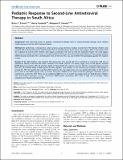| dc.contributor.author | Zanoni, Brian C | |
| dc.contributor.author | Sunpath, Henry | |
| dc.contributor.author | Feeney, Margaret E. | |
| dc.date.accessioned | 2013-04-22T15:18:35Z | |
| dc.date.issued | 2012 | |
| dc.identifier.citation | Zanoni, Brian C., Henry Sunpath, and Margaret E. Feeney. 2012. Pediatric response to second-line antiretroviral therapy in South Africa. PLoS ONE 7(11): e49591. | en_US |
| dc.identifier.issn | 1932-6203 | en_US |
| dc.identifier.uri | http://nrs.harvard.edu/urn-3:HUL.InstRepos:10579148 | |
| dc.description.abstract | Background: With improved access to pediatric antiretroviral therapy (ART) in resource-limited settings, more children could experience first-line ART treatment failure. Methods: We performed a retrospective cohort analysis using electronic medical records from HIV-infected children who initiated ART at McCord Hospital's Sinikithemba Clinic in KwaZulu-Natal, South Africa, from August 2003 to December 2010. We analyzed all records from children who began second-line ART due to first-line treatment failure. We used logistic regression to compare viral outcomes in Protease Inhibitor (PI)-based versus Non-Nucleoside Reverse Transcriptase Inhibitor (NNRTI)-based second-line ART, controlling for time on first-line ART, sex, and whether HIV genotyping guided the regimen change. Results: Of the 880 children who initiated ART during this time period, 80 (9.1%) switched to second-line ART due to therapeutic failure of first-line ART after a median of 95 weeks (IQR 65–147 weeks). Eight (10%) of the failures received NNRTI-based second-line ART, all of whom failed a PI-based first-line regimen. Seventy (87.5%) received PI-based second-line ART, all of whom failed a NNRTI-based first-line regimen. Two children (2.5%) received non-standard dual therapy as second-line ART. Six months after switching ART regimens, the viral suppression rate was significantly higher in the PI group (82%) than in the NNRTI group (29%; p = 0.003). Forty-one children (51%) were tested for genotypic resistance prior to switching to second-line ART. There was no significant difference in six month viral suppression (p = 0.38) between children with and without genotype testing. Conclusion: NNRTI-based second-line ART carries a high risk of virologic failure compared to PI-based second-line ART. | en_US |
| dc.language.iso | en_US | en_US |
| dc.publisher | Public Library of Science | en_US |
| dc.relation.isversionof | doi:10.1371/journal.pone.0049591 | en_US |
| dc.relation.hasversion | http://www.ncbi.nlm.nih.gov/pmc/articles/PMC3502491/pdf/ | en_US |
| dash.license | LAA | |
| dc.subject | Biology | en_US |
| dc.subject | Microbiology | en_US |
| dc.subject | Virology | en_US |
| dc.subject | Viral Classification | en_US |
| dc.subject | Retroviruses | en_US |
| dc.subject | Medicine | en_US |
| dc.subject | Clinical Research Design | en_US |
| dc.subject | Cohort Studies | en_US |
| dc.subject | Retrospective Studies | en_US |
| dc.subject | Infectious Diseases | en_US |
| dc.subject | Viral Diseases | en_US |
| dc.subject | HIV | en_US |
| dc.subject | HIV diagnosis and management | en_US |
| dc.subject | Retrovirology and HIV immunopathogenesis | en_US |
| dc.subject | Pediatrics | en_US |
| dc.title | Pediatric Response to Second-Line Antiretroviral Therapy in South Africa | en_US |
| dc.type | Journal Article | en_US |
| dc.description.version | Version of Record | en_US |
| dc.relation.journal | PLoS ONE | en_US |
| dash.depositing.author | Zanoni, Brian C | |
| dc.date.available | 2013-04-22T15:18:35Z | |
| dc.identifier.doi | 10.1371/journal.pone.0049591 | * |
| dash.contributor.affiliated | Zanoni, Brian | |


